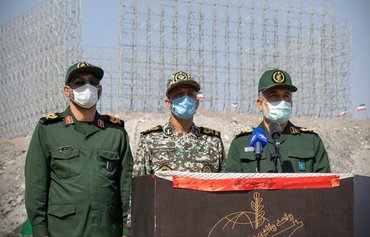A US Army missile system is keeping in check Iranian maritime capabilities that could attempt to block the Strait of Hormuz.
Iran in the past has threatened to close the strategic strait -- a passage less than 40km wide at its narrowest point.
Iran's naval capabilities include its regular navy, which uses conventional vessels, and the Islamic Revolutionary Guard Corps Navy (IRGCN)'s fleet of fast boats.
In recent years, the US and Iranian navies have had numerous tense encounters in the Persian Gulf, and especially near the strait.
![An Iranian warship takes part in 'National Persian Gulf Day' in the Strait of Hormuz on April 30, 2019. [Atta Kenare/AFP]](/cnmi_di/images/2021/09/29/31922-iran-warship-hormuz-600_384.jpg)
An Iranian warship takes part in 'National Persian Gulf Day' in the Strait of Hormuz on April 30, 2019. [Atta Kenare/AFP]
The United States on August 4 said Iran was involved in the hijacking of the Asphalt Princess, an asphalt and bitumen tanker, in the Gulf of Oman.
The US military on August 6 also concluded that Iran was behind a drone attack on the MT Mercer Street off the port of the Gulf Emirate of Fujairah on July 29, which killed the ship's Romanian captain and a British security guard.
To undercut Iranian naval and missile threats, the US military is turning toward the US Army's Army Tactical Missile Systems (ATACMS).
The Lockheed Martin-manufactured ATACMS have a range of up to 350km, and can be launched either from a Multiple Launch Rocket System (MLRS) or a High Mobility Artillery Rocket System (HIMARS).
They carry 227kg warheads, according to US Defence Department and Lockheed Martin data.
The latest Block IVA version, which includes an updated targeting system, makes it especially lethal to moving targets such as ships and mobile ballistic missile launchers.
If deployed in the United Arab Emirates, the ATACMS could sink Iranian naval ships in the Strait of Hormuz.
Alternatively, the missile could be used to target Iran's ballistic missile transporter-erector-launchers if launched from the Iraqi border.
The system provides a valuable alternative to sending aircraft on strike missions.
In the face of escalating tensions and threat of military conflict in the region, the United States, aided by allies throughout the region and around the globe, is policing sensitive waterways ranging from the narrow Strait of Hormuz to the sprawling Arabian Sea.
Destabilising agenda
The Iranian regime continues to pursue a destabilising agenda, mainly through the use of proxy militias in Iraq, Syria, Lebanon and Yemen. In addition to training, it provides them with illegal weapons smuggled in by air, land and sea.
Tehran's nuclear programme is also a threat.
In late May, the United Nations (UN) nuclear watchdog, the International Atomic Energy Agency (IAEA), voiced concern that Iran had not clarified queries over possible undeclared nuclear activity, adding that its enriched uranium stockpile was 16 times over the allowed limit.
These steps, among others, constitute violations of the 2015 nuclear deal that Iran signed with global powers, even as Tehran reconsiders the deal and is attempting to negotiate with the West for sanctions relief.
Meanwhile, Iran appears to be stonewalling observers.
The UN nuclear watchdog Sunday (September 26) said it had been denied "indispensable" access to the TESA Karaj centrifuge component manufacturing workshop in Iran, contrary to its September 12 agreement with Tehran.
On September 7, the IAEA had issued a strongly worded report in which it said its monitoring tasks in Iran had been "seriously undermined" after Tehran suspended some of the agency's inspections of the country's nuclear activities.
It noted that one of the cameras at a centrifuge component workshop in the city of Karaj was destroyed and another "severely damaged".

![An ATACMS being launched by an M270 MLRS in 2006. [US Army]](/cnmi_di/images/2021/09/29/31921-atacms-us-army-600_384.jpg)






